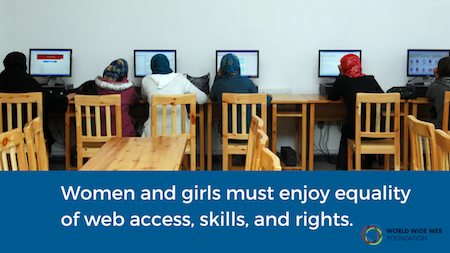
This is a cross-post from the Web Foundation website.
At the Web Foundation, we’re marking International Women’s Day by calling on governments to #BeBoldForChange — specifically, to be bold in prioritising policies that enhance women’s rights online. Information and communications technologies (ICTs) are important tools for women’s empowerment. Much has been written about the power of the internet to support women’s economic participation worldwide; equally as important — though less discussed — is the internet’s potential to expand women’s civic and political representation.
The internet not only provides women around the world with access to important information about their legal and political rights, but it also provides a platform to amplify women’s voices and build movements for change. Already this year, we’ve witnessed the incredible power of the internet to support women worldwide to organise and advocate collectively for government accountability to women’s rights: January 21, 2017 saw women’s marches organised in dozens of countries across every continent.
While reflecting on the importance of the web for women’s political voice and women’s rights movement building, it is also vital to recognise the formidable gender gaps in internet access, digital skills, and online rights and freedoms that continue to prevent the majority of women around the world from having a voice and participating as active citizens online. Gender disparities in internet access and use risk further marginalising women and ultimately will undermine efforts to foster a more gender equitable world.
Our Women’s Rights Online research — carried out in urban slum areas in 10 developing countries — reveals extreme gender inequalities in digital empowerment. Across poor areas in 10 cities, women are 50% less likely than men to be online, and 30-50% less likely to use the internet for economic and political empowerment. The root causes of this are high costs, lack of digital know-how, scarcity of content that is relevant and empowering for women, and barriers to women speaking freely and privately online. This connectivity gender gap means that hundreds of millions of women and girls are denied access to online education, health services, economic opportunity, political voice, and much more.
Furthermore, the internet’s role as a safe space for expression is being undermined by an epidemic of harassment and violence against women online, as well as growing intrusions on internet users’ right to privacy. In 74% of countries included in our Web Index study, law enforcement agencies and the courts are failing to take appropriate actions in situations where ICTs are used to commit acts of gender-based violence. Our Women’s Rights Online study found over six in ten of connected women and men aged 18-24 had experienced online harassment, rising to nearly seven in ten of the young women who use the internet daily. This is a matter of great concern for a number of reasons, not least because it was across this age group that we found greatest potential for women to leverage ICTs for empowerment.
If these trends do not change, the spread of ICTs could ultimately reinforce offline patterns of female subordination and silence. This may already be happening — while 62% of connected women we surveyed value the internet for posting comments about social, economic and political issues they care about, very few reported ever having actually done so. Our study also found that women in urban poor communities surveyed are 20% less likely than men to use the internet to find important information, and 52% less likely than men to express controversial views online. Another study by Intel found that in India and Egypt, one-fifth of women believe the internet is not appropriate for them.
The Sustainable Development Goals (SDGs) on women and technology (namely Goals 5b, 9c) provide a historic opportunity to halt and reverse growing digital inequality by turning political commitment into concrete interventions. However, without a major escalation of policy attention and investment, we run the risk that the technological change will continue to reinforce existing inequalities, social norms, and traditional gender roles.
Governments around the world have the power to turn this situation around by implementing gender-responsive technology policies that seek to further the rights and interests of women.
Here’s our five-step solution for how governments can REACT this International Women’s Day to amplify women’s voices and representation on and through the web:
R = Rights
- Protect and enhance women’s rights online.
E = Education
- Primary & secondary school curricula must incorporate digital skills training, and women must have equal access to tertiary education opportunities.
A = Access
- Deliver affordable — or free — access to an open web.
C = Content
- Ensure relevant content for women is available and used.
T = Targets
- Define, set and measure concrete gender-equity targets.
For more on our Women’s Rights Online Research and other Web Foundation projects, follow us on Twitter @webfoundation and sign up to receive our email updates
Leave a Reply
